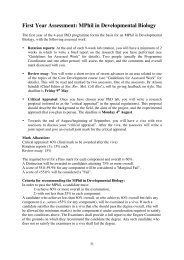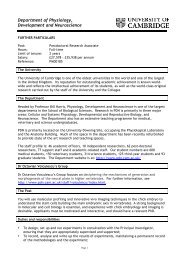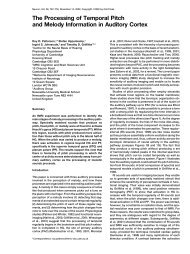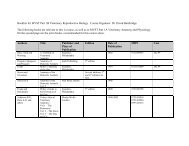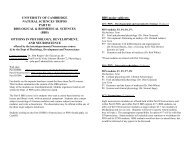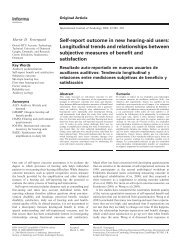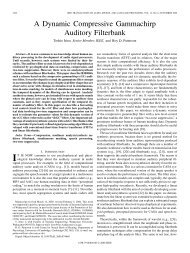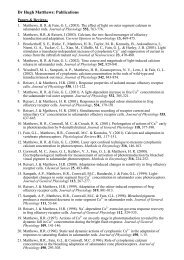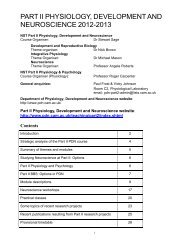FRIDAY MORNING, 20 MAY 2005 REGENCY E, 8:30 A.M. TO 12:00 ...
FRIDAY MORNING, 20 MAY 2005 REGENCY E, 8:30 A.M. TO 12:00 ...
FRIDAY MORNING, 20 MAY 2005 REGENCY E, 8:30 A.M. TO 12:00 ...
You also want an ePaper? Increase the reach of your titles
YUMPU automatically turns print PDFs into web optimized ePapers that Google loves.
10:<strong>00</strong>–10:10 Break<br />
10:10<br />
5aAB4. Estimating loudness in animals. Micheal L. Dent Dept. of Psych., 361 Park Hall, Univ. at Buffalo-SUNY, Buffalo, NY<br />
14260, mdent@buffalo.edu<br />
Although auditory acuity experiments in animals are valuable, this is not how animals typically encounter real world sounds. It is<br />
also important to know how animals respond to stimuli at more ‘‘realistic’’ intensities. The perception of above-threshold level sounds<br />
has been well documented in humans, but is much less studied in animals, where acoustic communication is important for survival.<br />
In humans, equal loudness contours are used to show that loudness does not increase with intensity equally at all frequencies.<br />
Loudness is a subjective experience, however, and much harder to measure in animals. Reaction time is one untrained response that<br />
can be used to gauge how different or similar two stimuli are: high intensities yield short and low intensities yield long reaction times.<br />
Comparing reaction times across frequencies equal latency contours in birds and mammals show results that are similar to equal<br />
loudness contours obtained in humans. At low SPLs equal-latency contours closely parallel threshold curves, while at high SPLs the<br />
contours flatten and all frequencies are perceived as being about the same loudness. These results in animals should be considered<br />
when thinking about aspects of acoustic communication such as sound transmission, vocal signals designs, and sound-attenuating<br />
properties of the environment.<br />
10:<strong>30</strong><br />
5aAB5. Animal behavioral psychoacoustics: Issues related to methodology and interpretation. David Kastak, Ronald<br />
Schusterman, Brandon Southall, Marla Holt UCSC Long Marine Lab., Santa Cruz, CA 95060, and Colleen Kastak UCSC Long<br />
Marine Lab., Santa Cruz, CA 95060<br />
A brief survey of the literature in animal behavioral psychophysics shows that researchers use numerous methods to obtain<br />
information on sound detection, discrimination, and identification. Behavioral methodology in animal psychoacoustics includes both<br />
classical and operant conditioning, go/no-go or multiple alternative forced-choice tasks, and various methods of estimating detection<br />
and discrimination thresholds. Recent emphasis on comparing data across subjects, species, and media e.g., hearing in air versus<br />
water, as well as investigations into the effects of age, noise, and ototoxins on auditory perception highlight the need for methodological<br />
standardization. In this paper we will discuss several important issues related to behavioral audiometrics, focusing primarily<br />
on marine mammals. These issues include variability among species, individual subjects, and laboratories; experimental concerns such<br />
as time constraints; adaptive versus non-adaptive psychophysical methodology and threshold reliability; signal detection theory versus<br />
threshold models of audition and the search for unbiased estimates of auditory performance; and measurement and interpretation of<br />
subject response bias. Standards for animal psychoacoustic methodology should be sensitive to each of these factors.<br />
10:50<br />
5aAB6. Body size and assessment of auditory function: A comparative conundrum. Edward J. Walsh, JoAnn McGee Boys<br />
Town Natl. Res. Hospital, Omaha, NE 68131, John Rosowski, and William Peake Harvard Med. School, Boston, MA 02115<br />
One goal of the bioacoustics community is to compare auditory function among species representing the entire animal kingdom,<br />
including terrestrial mammals. As an alternative to behavioral measures, it is frequently necessary, and/or desirable, to assess auditory<br />
function using electrophysiological approaches. Body size is an important factor that can effect the distribution and amplitude of<br />
evoked brain potentials EP measured from the surface of the head and the ranges of body mass and size within Mammalia are<br />
extensive. Consequently, the development of comparison protocols must include consideration of factors affected by size differences,<br />
e.g., the distance between EP generators and recording electrodes and the thickness of the skull. Ultimately, these factors, along with<br />
the acoustical character of the recording environment itself, affect acquired signal-to-noise ratios SNR. In this context it is notable<br />
that the SNR associated with large animals are reduced relative to those observed in smaller animals, making the comparison of results<br />
from one species to another complex. This procedural challenge is further complicated by the requirement to acquire data efficiently<br />
and rapidly in recording environments that are non-optimal from an acoustic perspective. These issues will be addressed by considering<br />
auditory brainstem responses in tigers, bobcats, manuls, sandcats and rodents.<br />
11:10<br />
5aAB7. Psychometric data and standards for the estimation of noise exposure for animals. Ann E. Bowles Hubbs-SeaWorld<br />
Res. Inst., 2595 Ingraham St., San Diego, CA 92109, annb1@san.rr.com<br />
ASA standards are used in the estimation of noise exposure for humans. The approaches pioneered for humans can be used as a<br />
model for animal standards, but a number of differences must be considered. First, animal standards will normally be applied across<br />
multiple taxa rather than to a single, monotypic species. Thus, it will be essential to find defensible methods for generalizing across<br />
taxa. Second, samples of subjects and measurement conditions are often inadequate in animal studies e.g., measurements on a single<br />
animal, noisy testing conditions, but may be the only data available. Therefore, standards are needed for specifying the limitations of<br />
various data sources. Third, taxa may have very different psychoacoustic capabilities e.g., best sensitivity, temporal integration time,<br />
and loudness perception. Therefore, comparative measures will be essential. For example, while weighting functions for humans are<br />
standardized to zero at 1 kHz, there are advantages to developing weighting functions for animals with an appropriate correction for<br />
taxon-specific sensitivity. Although the differences between standards for animals and humans represent a significant challenge, the<br />
development process and research in support of animal standards will yield valuable new perspectives that could be applied to humans<br />
in the future.<br />
5a FRI. AM<br />
2583 J. Acoust. Soc. Am., Vol. 117, No. 4, Pt. 2, April <strong>20</strong>05 149th Meeting: Acoustical Society of America 2583



